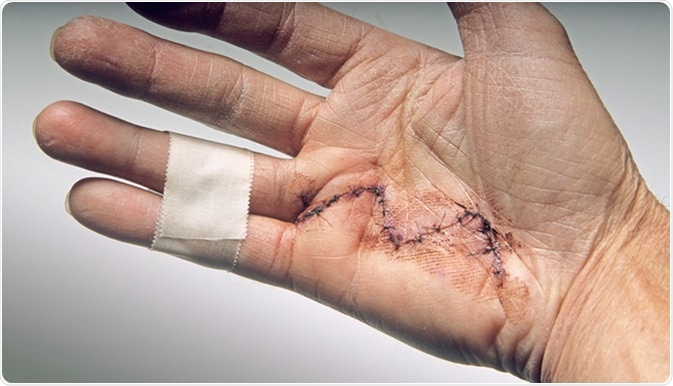Dupuytren’s contracture is a disease which impacts one’s fingers and hands. The condition essentially causes the tendons in the hand and fingers to pull, or contract, toward the palm, where the tissue has thickened. Sometimes Dupuytren’s affects both hands simultaneously, but it also can affect just one.
When the palm tissue becomes thick, the thickness initially occurs in a small area, causing a benign lump, or nodule, to form beneath the skin. The nodule is sometimes tender initially , but becomes hard over time. More nodules may then develop. The condition is not life-threatening, however it is discomforting.
The most common successful treatment for Dupuytren’s has been surgery. A physician may consider surgical intervention when the fingers are impeded enough so as to make one’s lifestyle or work difficult. While surgery can straighten any contractured fingers, it cannot cure the disease. Eventually contracture issues may occur again.

Hand surgery done to alleviate Dupuytren's contracture. Image Credit: Christian Delbert / Shutterstock
Surgical Options
Key surgical options include:
- A fasciotomy, in which a surgeon cuts connective tissue to eliminate tension in the hand. This procedure usually is reserved for mild conditions.
- A fasciectomy, in which a surgeon completely takes out the connective tissue. This is reserved for advanced or chronic conditions.
A fasciotomy can either be a needle fasciotomy or an open fasciotomy.
The needle fasciotomy is an out-patient procedure that involves a local anesthetic, straightens any bent fingers with minimal side effects and recreates functional fingers and hands, sometimes with the help of physical therapy. It is often the traditional treatment for mild Dupuytren’s. But some surgeons find that removing the tissue may be more effective, in some instances, rather than just cutting it.
A fine needle is inserted into the fiber-rich cords in either the palm or fingers. The instrument cuts through the cord beneath the skin. Cutting the hardened tissue eliminates the tightness that was forcing the finger into its bent position.
The open fasciotomy, which can be applied to treat severe Dupuytren’s, is more effective compared to a needle fasciotomy over a longer period of time. As with a needle fasciotomy, it is also an outpatient procedure which uses a a local anesthetic. A cut is made into the skin to access to connective tissue below the surface. The hardened connective tissue is cut and divided to straighten the fingers.
After surgery, the cut is stitched and treated. The incision takes time to heal. Eventually, the stitches will be removed. But a scar may remain.
With a fasciectomy, the hardened connective tissue and skin are removed. In a selective fasciectomy, a surgeon removes just the connective tissue that is affected. With a complete fasciectomy, the surgeon eliminates all connective tissue. In a dermo-fasciectomy, the wound is covered using a skin graft after the surgeon removes all connective tissue. The initial procedure may involve a partial fasciectomy, in which a zigzag-like cut is made over the target area, making for easy access, and allowing the wound to contract a little after healing so that the scar is not too tight.
Dupuytren's contracture: what is the success rate of surgery ?
Potential Complications
Because a fasciectomy is comparatively a more extensive procedure, the risk of complication is slightly greater (about 5%) than that with a fasciotomy. However, more extensive surgery leads to longer-lasting results. There is an approximate 8% chance of recurrence after a dermo-fasciectomy. Potential surgical risks include:
- Skin splitting
- Damaging blood vessels or the nerves supplying to the fingertips
- Joint stiffness, although this can be modified with therapy
- Infection
There are options beyond surgery, including massage and physical therapy, or the application of radiation, which could either eliminate or delay surgical procedures.
Recovery
Recovery of partial or complete hand functionality may require a long period of time after surgery. Usually, the more extensive surgery requires a longer recovery time. Recovery may be painful, and pain medication may be required. Generally, activities will be limited for about a month because of pain, stiffness, and swelling.
In terms of therapy, post-surgical options include physical therapy that optimizes the movement range through manipulation or massage, or occupational therapy using assessment and intervention to reach recovery. Hand therapy may be needed for about half-a-year after extensive surgery.
Hand splints are an option. Splints may influence the manner in which scar tissue forms. Splinting entails bandaging the fingers to a strip in a comfortable position. Splints may be required all day or only overnight.
Being able to drive a vehicle and return to work will depend on the nature of one’s job, such as if it involves manual labor, and the extent of the operation.
Further Reading
Last Updated: Dec 29, 2022